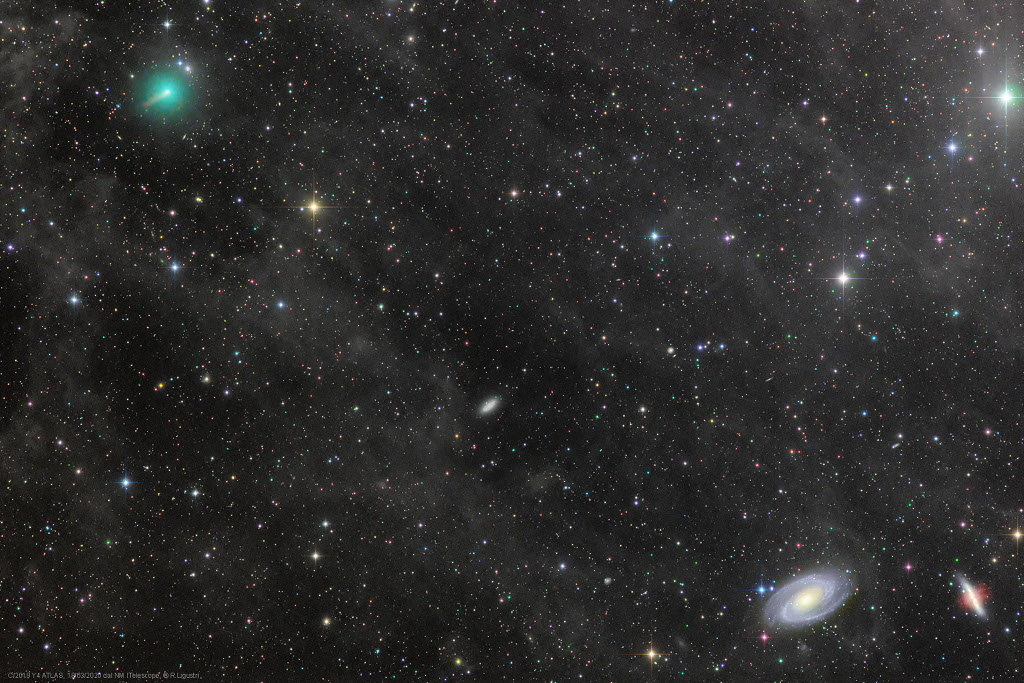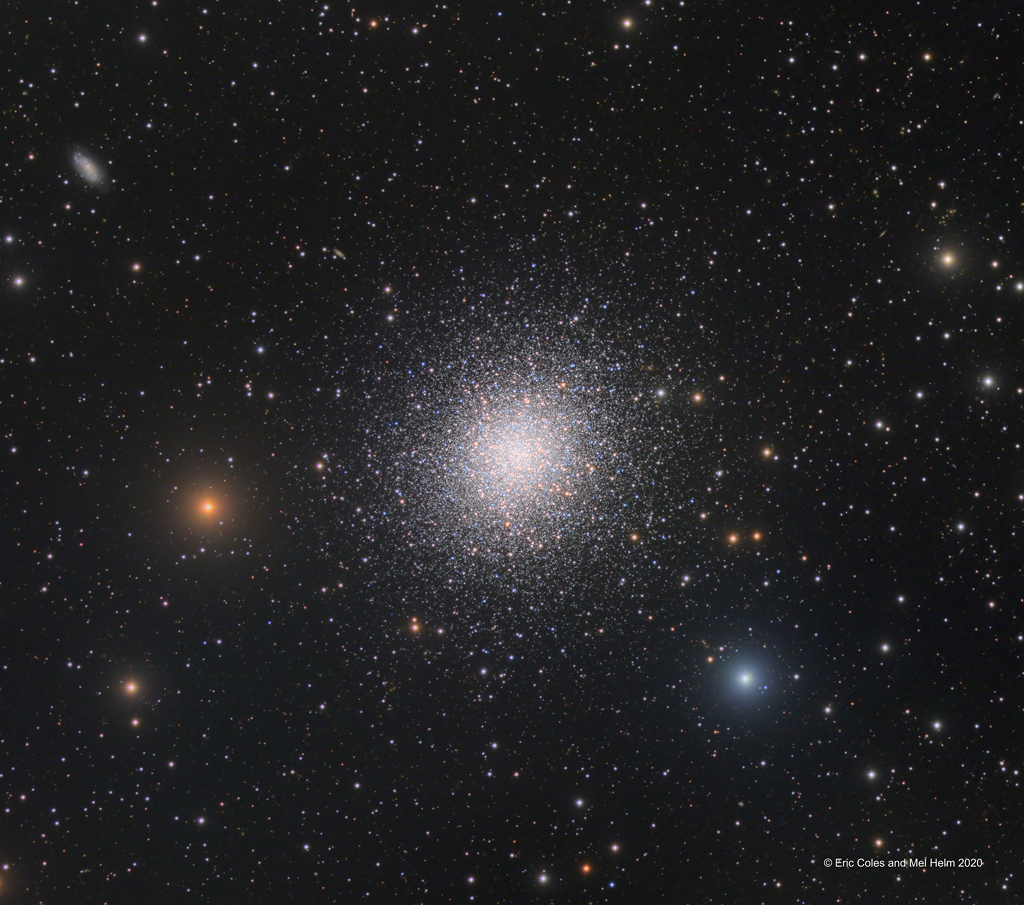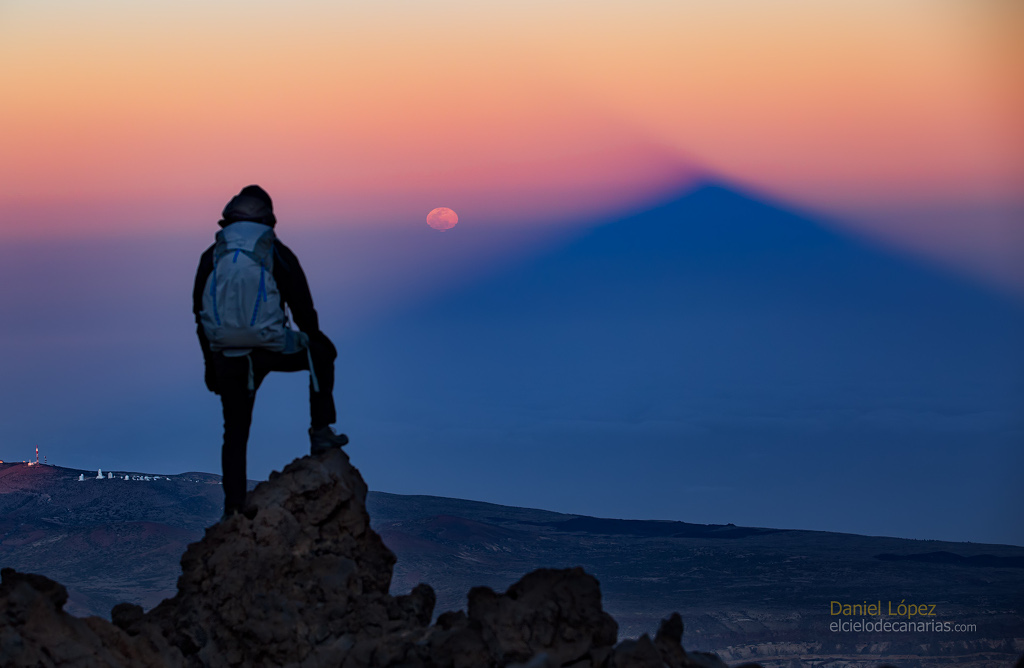These people are not in danger. What is coming down from the left is just the Moon, far in the distance. Luna appears so large here because she is being photographed through a telescopic lens. What is moving is mostly the Earth, whose spin causes the Moon to slowly disappear behind Mount Teide, a volcano in the Canary Islands off the northwest coast of Africa. The people pictured are 16 kilometers away and many are facing the camera because they are watching the Sun rise behind the photographer. It is not a coincidence that a full moon rises just when the Sun sets because the Sun is always on the opposite side of the sky from a full moon. The featured video was made two years ago during the full Milk Moon. The video is not time-lapse — this was really how fast the Moon was setting. via NASA https://ift.tt/39asyhG
Archives mensuelles : mars 2020
Comet ATLAS and the Mighty Galaxies

Comet ATLAS C/2019 Y4 was discovered by the NASA funded Asteroid Terrestrial-impact Last Alert System, the last comet discovery reported in 2019. Now growing brighter in northern night skies, the comet’s pretty greenish coma is at the upper left of this telescopic skyview captured from a remotely operated observatory in New Mexico on March 18. At lower right are M81 and M82, well-known as large, gravitationally interacting galaxies. Seen through faint dust clouds above the Milky Way, the galaxy pair lies about 12 million light-years distant, toward the constellation Ursa Major. In bound Comet ATLAS is about 9 light-minutes from Earth, still beyond the orbit of Mars. The comet’s elongated orbit is similar to orbit of the Great Comet of 1844 though, a trajectory that will return this comet to the inner Solar System in about 6,000 years. Comet ATLAS will reach a perihelion or closest approach to the Sun on May 31 inside the orbit of Mercury and may become a naked-eye comet in the coming days. via NASA https://ift.tt/2U8fXYg
Morning, Planets, Moon, and Montreal

Dawn’s early light came to Montreal, northern planet Earth, on March 18, the day before the vernal equinox. At the end of that nearly equal night the Moon stands above a dense constellation of urban lights in this serene city and skyscape. Of course the Moon’s waning crescent faces toward the rising Sun. Skygazers could easily spot bright Jupiter just above the Moon, close on the sky to a fainter Mars. Saturn, a telescopic favorite, is just a pinprick of light below and farther left of the closer conjunction of Moon, Jupiter and Mars. Near the ecliptic, even Mercury is rising along a line extended to the horizon from Jupiter and Saturn. The elusive inner planet is very close to the horizon though, and not quite visible in this morning’s sky. via NASA https://ift.tt/2J3rt0B
M13: The Great Globular Cluster in Hercules

In 1716, English astronomer Edmond Halley noted, « This is but a little Patch, but it shews itself to the naked Eye, when the Sky is serene and the Moon absent. » Of course, M13 is now less modestly recognized as the Great Globular Cluster in Hercules, one of the brightest globular star clusters in the northern sky. Sharp telescopic views like this one reveal the spectacular cluster’s hundreds of thousands of stars. At a distance of 25,000 light-years, the cluster stars crowd into a region 150 light-years in diameter. Approaching the cluster core upwards of 100 stars could be contained in a cube just 3 light-years on a side. For comparison, the closest star to the Sun is over 4 light-years away. The remarkable range of brightness recorded in this image follows stars into the dense cluster core and reveals three subtle dark lanes forming the apparent shape of a propeller just below and slightly left of center. Distant background galaxies in the medium-wide field of view include NGC 6207 at the upper left. via NASA https://ift.tt/393u7hE
Anticrepuscular Rays over Florida

What’s happening behind those clouds? Although the scene may appear somehow supernatural, nothing more unusual is occurring than a Sun setting on the other side of the sky. Pictured here are anticrepuscular rays. To understand them, start by picturing common crepuscular rays that are seen any time that sunlight pours though scattered clouds. Now although sunlight indeed travels along straight lines, the projections of these lines onto the spherical sky are great circles. Therefore, the crepuscular rays from a setting (or rising) sun will appear to re-converge on the other side of the sky. At the anti-solar point 180 degrees around from the Sun, they are referred to as anticrepuscular rays. Featured here is a particularly striking display of anticrepuscular rays photographed in 2016 over Dry Tortugas National Park in Florida, USA. via NASA https://ift.tt/38TV7ju
M77: Spiral Galaxy with an Active Center

What’s happening in the center of nearby spiral galaxy M77? The face-on galaxy lies a mere 47 million light-years away toward the constellation of the Sea Monster (Cetus). At that estimated distance, this gorgeous island universe is about 100 thousand light-years across. Also known as NGC 1068, its compact and very bright core is well studied by astronomers exploring the mysteries of supermassive black holes in active Seyfert galaxies. M77 and its active core glows bright at x-ray, ultraviolet, visible, infrared, and radio wavelengths. The featured sharp image of M77 was taken by the Hubble Space Telescope and is dominated by the (visible) red light emitted by hydrogen. The image shows details of the spiral’s winding spiral arms as traced by obscuring dust clouds, and red-tinted star forming regions close in to the galaxy’s luminous core. via NASA https://ift.tt/39ZPt0s
A Moon Dressed Like Saturn

Why does Saturn appear so big? It doesn’t — what is pictured are foreground clouds on Earth crossing in front of the Moon. The Moon shows a slight crescent phase with most of its surface visible by reflected Earthlight known as ashen glow. The Sun directly illuminates the brightly lit lunar crescent from the bottom, which means that the Sun must be below the horizon and so the image was taken before sunrise. This double take-inducing picture was captured on 2019 December 24, two days before the Moon slid in front of the Sun to create a solar eclipse. In the foreground, lights from small Guatemalan towns are visible behind the huge volcano Pacaya. via NASA https://ift.tt/2wb0VHU
The Snows of Churyumov Gerasimenko
You couldn’t really be caught in this blizzard while standing by a cliff on Churyumov-Gerasimenko. Orbiting the comet — frequently abbreviated as 67P or CG — in June of 2016, the Rosetta spacecraft’s narrow angle camera did record streaks of dust and ice particles — similar to snow — as they drifted across the field of view near the camera and above the comet’s surface. Some of the bright specks in the scene, however, are likely due to a rain of energetic charged particles or cosmic rays hitting the camera, and the dense background of stars in the direction of the constellation of the Big Dog (Canis Major). In the featured video, these background stars are easy to spot trailing from top to bottom. The stunning movie was constructed from 33 consecutive images taken over 25 minutes while Rosetta cruised some 13 kilometers from the comet’s nucleus. via NASA https://ift.tt/38My4a9
Moonrise and Mountain Shadow

What phase of the Moon is 3.14 radians from the Sun? The Full Moon, of course. Even though the Moon might look full for several days, the Moon is truly at its full phase when it is 3.14 radians (aka 180 degrees) from the Sun in ecliptic longitude. That’s opposite the Sun in planet Earth’s sky. Rising as the Sun set on March 9, only an hour or so after the moment of its full phase, this orange tinted and slightly flattened Moon still looked full. It was photographed opposite the setting Sun from Teide National Park on the Canary Island of Tenerife. Also opposite the setting Sun, seen from near the Teide volcano peak about 3,500 meters above sea level, is the mountain’s rising triangular shadow extending into Earth’s dense atmosphere. Below the distant ridge line on the left are the white telescope domes of Teide Observatory via NASA https://ift.tt/2Q96ZaT
Starry Night by Jean François Millet

A dramatic nocturnal landscape from around 1850, this oil painting is the work of French artist Jean-Francois Millet. In the dark and atmospheric night sky are shooting stars, known too as meteors, above a landscape showing a path through the faintly lit countryside that leads toward trees and a cart in silhouette on the horizon. Millet was raised in a farming family in Normandy and is known for his paintings of rural scenes and peasant life. This Starry Night was painted after the artist moved to Barbizon, about 30 kilometers southeast of any 19th century light pollution from Paris. Millet wrote to his brother at this time, « If only you knew how beautiful the night is … the calm and grandeur of it are so awesome that I find that I actually feel overwhelmed. » Dutch artist Vincent van Gogh was an admirer of Millet’s work, and later also painted two dramatic starry nights. via NASA https://ift.tt/2TJyl9D